tow Oldsmobile Achieva 1998 s Owner's Guide
[x] Cancel search | Manufacturer: OLDSMOBILE, Model Year: 1998, Model line: Achieva, Model: Oldsmobile Achieva 1998Pages: 356, PDF Size: 18.04 MB
Page 188 of 356
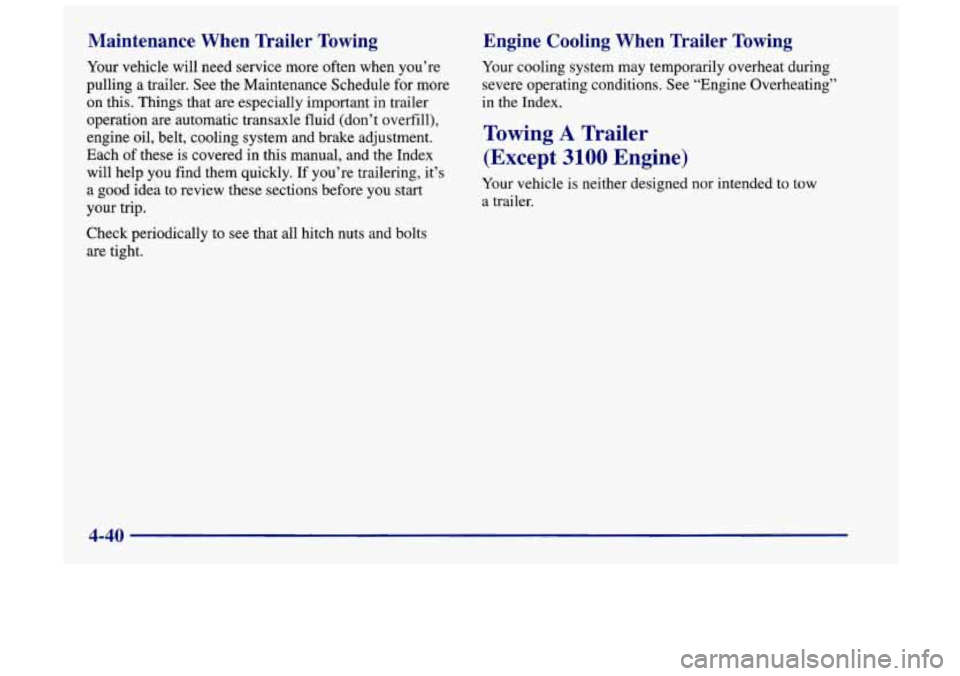
Maintenance When Trailer Towing
Your vehicle will need service more often when you’re
pulling a trailer. See the Maintenance Schedule for more
on this. Things that are especially important in trailer
operation are automatic transaxle fluid (don’t overfill),
engine oil, belt, cooling system and brake adjustment.
Each
of these is covered in this manual, and the Index
will help you find them quickly. If you’re trailering, it’s
a good idea to review these sections before you
start
your trip.
Check periodically to
see that all hitch nuts and bolts
are tight.
Engine Cooling When Trailer Towing
Your cooling system may temporarily overheat during
severe operating conditions. See “Engine Overheating’’
in the Index.
Towing A Trailer
(Except 3100 Engine)
Your vehicle is neither designed nor intended to tow
a trailer.
4-40
Page 189 of 356
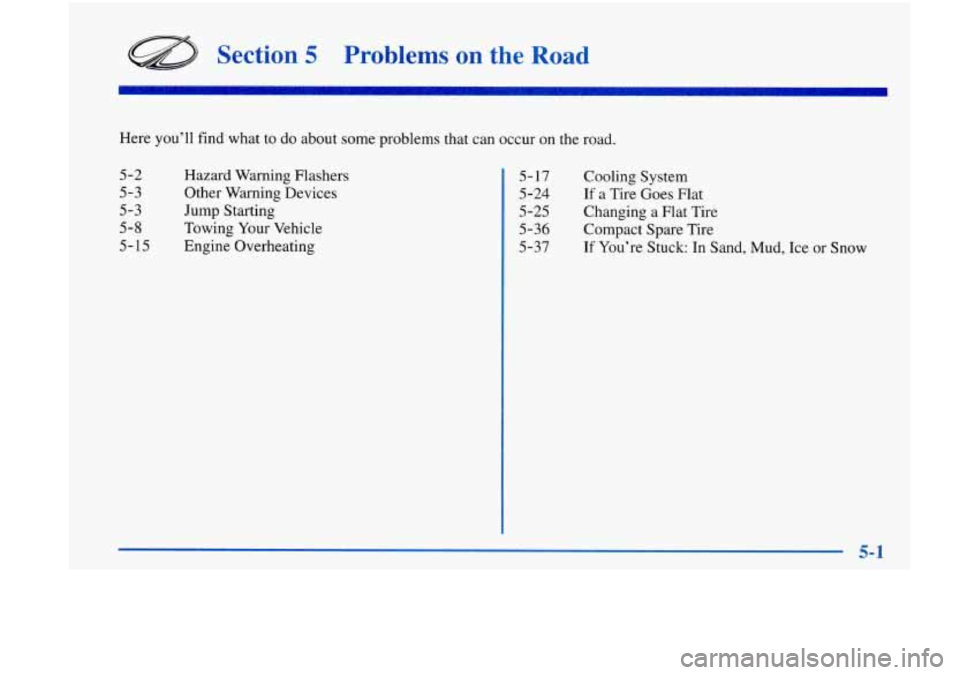
Section 5 Problems on the Road
Here you’ll find what to do about some problems that can occur on the road.
5-2 Hazard Warning Flashers
5- 17 Cooling System
5-3 Other Warning Devices
5-3 Jump Starting
5 -24 If a Tire Goes Flat
5-25 Changing a Flat Tire
5-8 Towing Your Vehicle
5-36 Compact Spare Tire
5-
15 Engine Overheating 5-37 If You’re Stuck: In Sand, Mud, Ice or Snow
Page 196 of 356
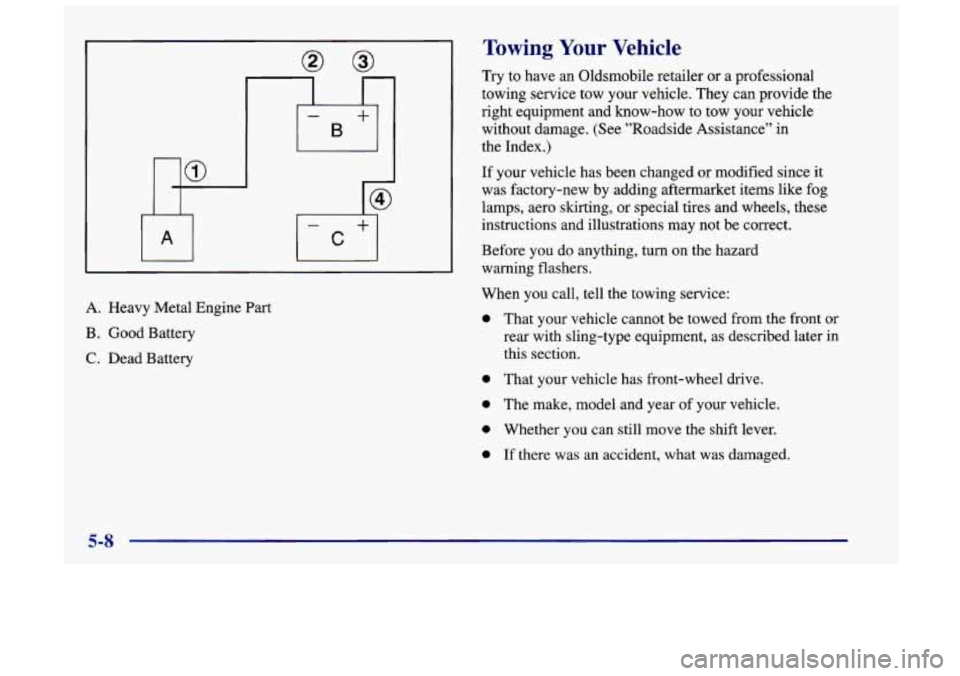
- +
B
A. Heavy Metal Engine Part
B. Good Battery
C. Dead Battery
Towing Your Vehicle
Try to have an Oldsmobile retailer or a professional
towing service tow your vehicle. They can provide the
right equipment and know-how to tow your vehicle
without damage. (See ”Roadside Assistance” in
the Index,)
If your vehicle has been changed or modified since it
was factory-new by adding aftermarket items like fog
lamps, aero skirting, or special tires and wheels, these
instructions and illustrations may not be correct.
Before you
do anything, turn on the hazard
warning flashers.
When you call, tell the towing service:
0
0
0
0
0
That your vehicle cannot be towed from the front or
rear with sling-type equipment, as described later in
this section.
That your vehicle has front-wheel drive. The make, model and year of your vehicle.
Whether
you can still move the shift lever.
If there was an accident, what was damaged.
5-8
Page 197 of 356

When the towing service arrives, let the tow operator
know that this manual contains detailed towing
instructions and illustrations. The operator may want
to see them.
1
A CAL
t To help avoid injury to you or otk 's:
I'
0
0
0
0
0
Never let passengers ride in a vehicle that is
being towed.
Never tow faster than safe or posted speeds.
Never tow with damaged parts not
fully secured.
Never get under your vehicle after
it has
been lifted by the tow truck.
Always secure the vehicle on each side with
separate safety chains when towing it.
Never use J-hooks. Use T-hooks instead.
5-9
Page 198 of 356
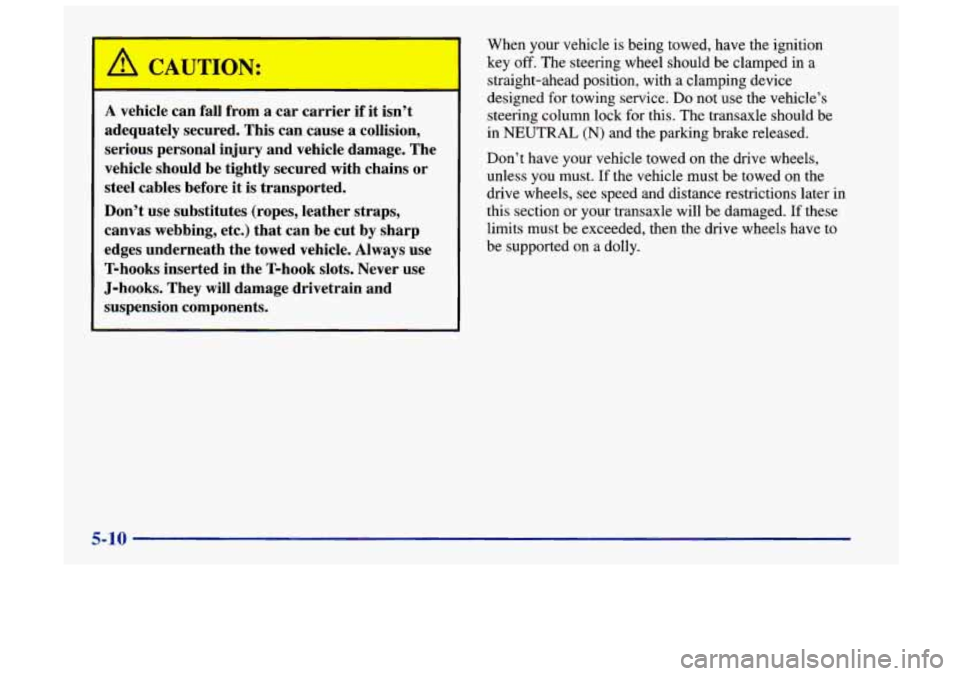
!L CAUTION:
A vehicle can fall from a car carrier if it isn’t
adequately secured. This can cause a collision,
serious personal injury and vehicle damage. The
vehicle should be tightly secured with chains or
steel cables before it is transported.
Don’t use substitutes (ropes, leather straps,
canvas webbing, etc.) that can be cut by sharp
edges underneath the towed vehicle. Always use
T-hooks inserted in the T-hook slots. Never use
J-hooks. They will damage drivetrain and
suspension components.
When your vehicle is being towed, have the ignition
key off. The steering wheel should be clamped
in a
straight-ahead position, with
a clamping device
designed for towing service. Do not use the vehicle’s
steering column lock for this. The transaxle should be
in
NEUTRAL (N) and the parking brake released.
Don’t have your vehicle towed on the drive wheels,
unless you must. If the vehicle must be towed on the
drive wheels, see speed and distance restrictions later
in
this section or your transaxle will be damaged. If these
limits must be exceeded, then the drive wheels have to
be supported on a dolly.
5-10
-
Page 199 of 356
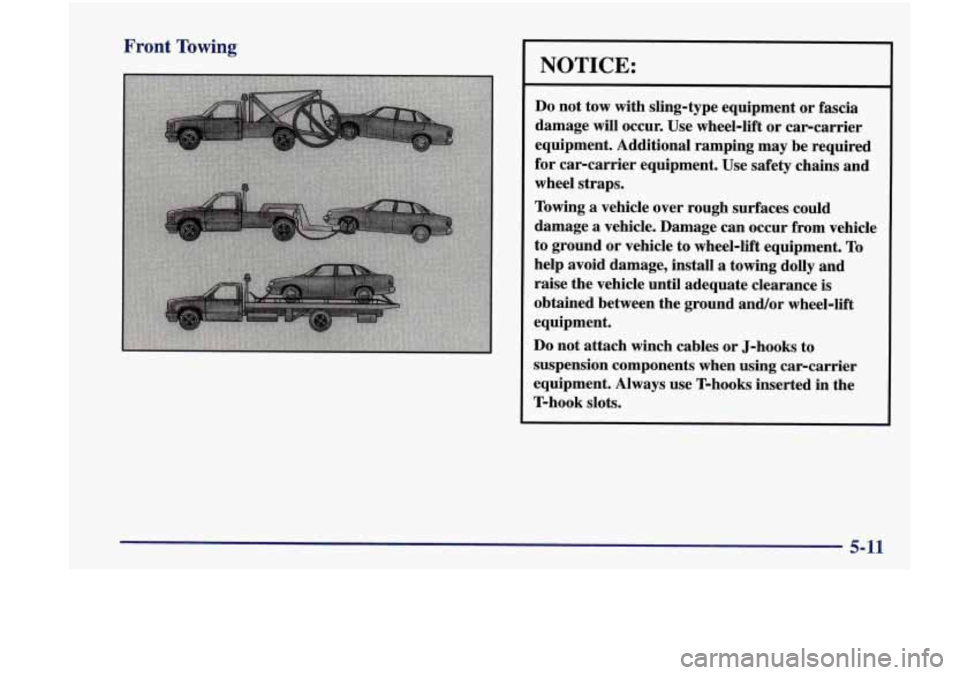
Front Towing
NOTICE:
Do not tow with sling-type equipment or fascia
damage
will occur. Use wheel-lift or carcarrier
equipment. Additional ramping may be required
for car-carrier equipment. Use safety chains and
wheel straps.
Towing
a vehicle over rough surfaces could
damage
a vehicle. Damage can occur from vehicle
to ground or vehicle to wheel-lift equipment. To
help avoid damage, install
a towing dolly and
raise the vehicle until adequate clearance is
obtained between the ground and/or wheel-lift
equipment.
Do not attach winch cables or J-hooks to
suspension components when using car-carrier
equipment. Always use T-hooks inserted in the
T-hook slots.
5-11
Page 201 of 356
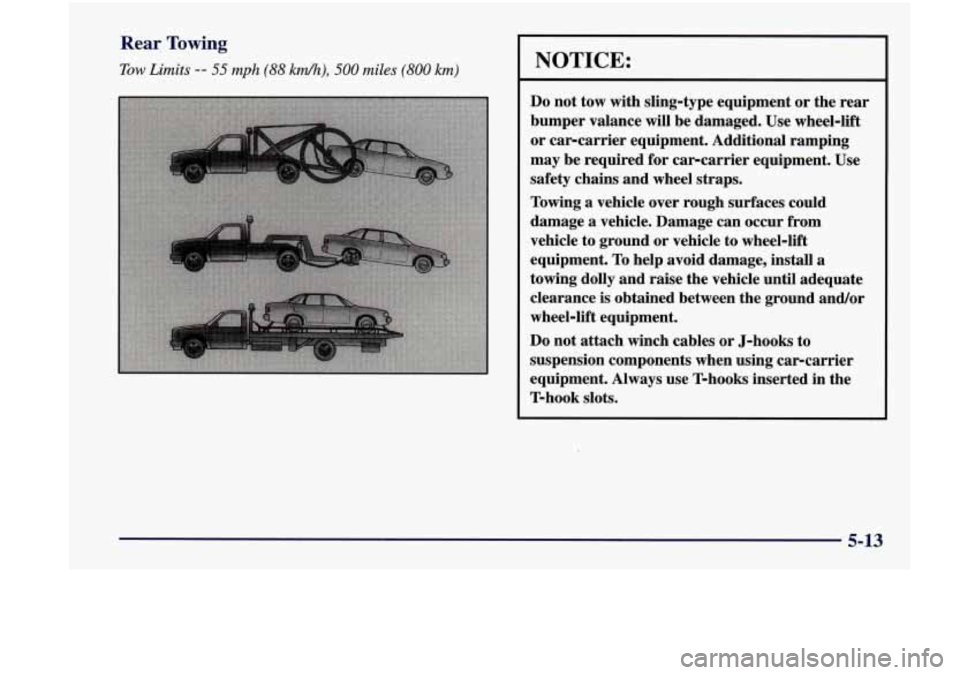
Rear Towing
Tow Limits -- 55 mph (88 kd), 500 miles (800 km) NOTICE:
Do not tow with sling-type equipment or the rear
bumper valance will be damaged. Use wheel-lift
or carcarrier equipment. Additional ramping
may be required for carcarrier equipment. Use
safety chains and wheel straps.
Towing a vehicle over rough surfaces could
damage
a vehicle. Damage can occur from
vehicle to ground or vehicle to wheel-lift
equipment. To help avoid damage, install
a
towing dolly and raise the vehicle until adequate
clearance
is obtained between the ground and/or
wheel-lift equipment.
Do not attach winch cables or J-hooks to
suspension components when using car-carrier
equipment. Always use T-hooks inserted in the
T-hook slots.
5-13
Page 202 of 356

NOTICE:
Do not have your vehicle towed with the front
wheels in contact with the ground. This will
damage the transaxle. If the vehicle must be
towed on the front wheels, it cannot be towed
more than a total of
500 miles (800km) for the
lifetime of the vehicle.
NOTE: The ignition must be in the OFF position to keep
automatic door locks from locking during
tow.
Attach T-hook chains on
both sides in the slotted
holes in the bottom of the
frame rail just ahead of the
These slots are
to be used when loading and securing to
car-carrier equipment.
Attach
a separate safety
chain to each side
of the
axle inboard
of the spring.
5-14
Page 204 of 356

If No Steam Is Coming From Your Engine
If you get the overheat warning but see or hear no
steam, the problem may not be too serious. Sometimes
the engine can get a little too hot when you:
Climb a long hill on a hot day.
Stop after high-speed driving.
Idle for long periods in traffic.
Tow a trailer.
If you get the overheat warning with no sign of steam,
try this for a minute or
so:
1. Turn off your air conditioner.
2. Turn on your heater to full hot at the highest fan
speed and open the window as necessary.
3. If you’re in a traffic jam, shift to NEUTRAL (N);
otherwise, shift to the highest gear while
driving
-- AUTOMATIC OVERDRIVE (@)
or DRIVE (D).
If you no longer have the overheat warning, you can
drive. Just to be safe, drive slower for about
10 minutes.
If the warning doesn’t come back on, you can
drive normally.
If the warning continues, pull over,
stop, and park your
vehicle right away.
If there’s still no sign of steam, you can idle the engine
for two or three minutes while you’re parked, to see if
the warning stops. But then, if you still have the
warning, turn oathe engine
and get everyone out of the
vehicle until it cools down.
You may decide not to lift the hood but to get service
help right away.
5-16
Page 212 of 356
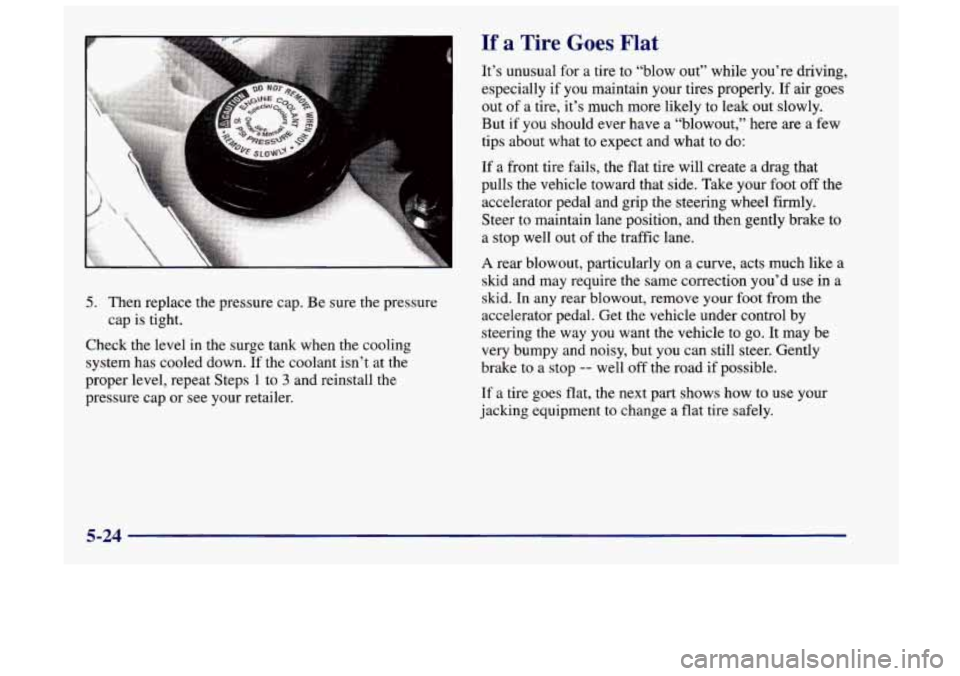
5. Then replace the pressure cap. Be sure the pressure
Check the level in the surge tank when the cooling
system has cooled down. If the coolant isn’t at the
proper level, repeat Steps
1 to 3 and reinstall the
pressure cap or
see your retailer.
cap
is tight.
If a Tire Goes Flat
It’s
unusual for a tire to “blow out” while you’re driving,
especially if you maintain your tires properly. If
air goes
out of a tire, it’s much more likely to leak out slowly.
But
if you should ever have a “blowout,” here are a few
tips about what to expect and what to do:
If a front tire fails, the flat tire will create a drag that
pulls the vehicle toward that side. Take your foot off the
accelerator pedal and grip the steering wheel firmly.
Steer to maintain lane position, and then gently brake to
a stop well out of the traffic lane.
A rear blowout, particularly on a curve, acts much like a
skid and may require the same correction you’d use in a
skid. In any rear blowout, remove your foot from the
accelerator pedal. Get the vehicle under control by
steering the way you want the vehicle to go. It may be
very bumpy and noisy, but you can still steer. Gently
brake to a stop
-- well off the road if possible.
If a tire goes flat, the next part shows how to use your
jacking equipment to change a flat tire safely.
5-24